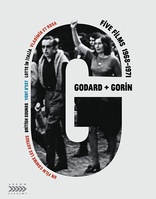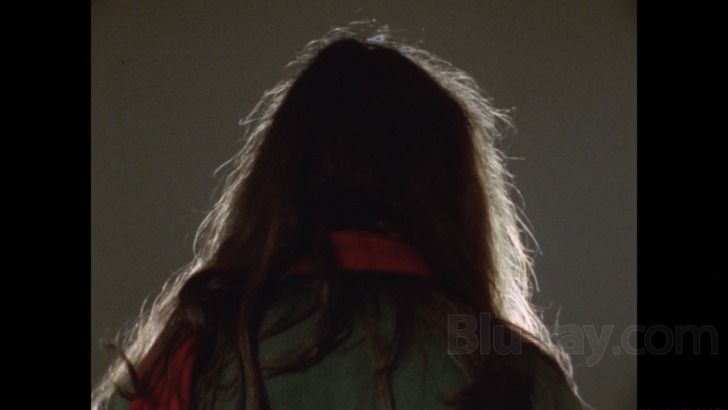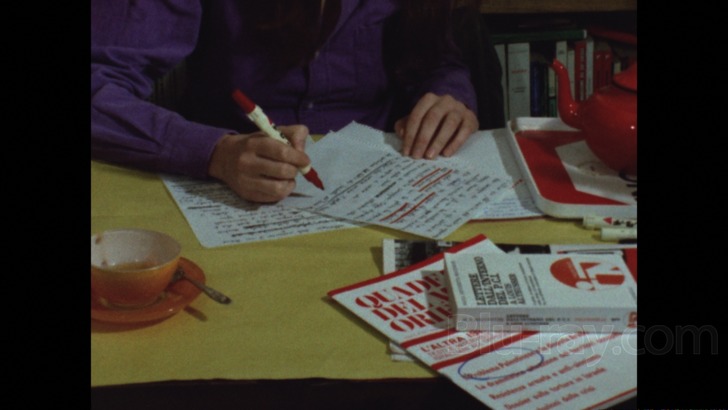Lotte in Italia Blu-ray Movie
HomeLotte in Italia Blu-ray Movie 
Struggle in ItalyArrow | 1971 | 62 min | Not rated | No Release Date

Price
Movie rating
7.1 | / 10 |
Blu-ray rating
| Users | 0.0 | |
| Reviewer | 3.0 | |
| Overall | 3.0 |
Overview
Lotte in Italia (1971)
A revolutionary Italian woman falls prey to bourgeois ideology.
Director: Jean-Luc Godard| Foreign | 100% |
| Drama | 79% |
Specifications
Video
Video codec: MPEG-4 AVC
Video resolution: 1080p
Aspect ratio: 1.33:1
Original aspect ratio: 1.37:1
Audio
French: LPCM Mono
Subtitles
English SDH
Discs
Blu-ray Disc
Single disc (1 BD)
Playback
Region A (B, C untested)
Review
Rating summary
| Movie | 3.0 | |
| Video | 4.0 | |
| Audio | 4.0 | |
| Extras | 0.5 | |
| Overall | 3.0 |
Lotte in Italia Blu-ray Movie Review
Reviewed by Jeffrey Kauffman March 10, 2018Note: This film is available as part of the box set Jean-Luc Godard + Jean-Pierre Gorin: Five Films, 1968-1971.
If you were asked to name just one film by iconic director Jean-Luc Godard, which one would you choose? Chances are for many of you it would
probably be his legendary pioneering New Wave entry Breathless,
or perhaps one of his better remembered titles from a bit later in his career like Alphaville or Masculin Féminin
.
Even if your particular choice wouldn’t in fact be one of these three films, this very trio in and of itself proves quite admirably how widely variant
the
content in Godard’s films can be, even if his style is often instantly recognizable. As perhaps evidenced by the title of what is the last film Godard
has
come out with (he’s still alive and kicking at 87 as this review is being written), 2014’s Goodbye to Language, Godard is often interested in the visceral intensity of imagery, imagery that is often either
divorced or at least tangentially related to any perceived content. In our recent Faces Places Blu-ray review, a film which has both subliminal and overt references to Jean-Luc Godard, I jokingly
referred to the five films in this set as among the "vaguest" of the Nouvelle Vague. In fact what is repeatedly so fascinating about these
five
admittedly odd films is how their presentational aspects are almost deliberately opaque, while some of their actual content is virtually screed like,
as Godard, probably already prone toward anarchistic tendencies, tipped over into what some have called "radicalization" in the wake of
sociopolitical unrest in the France of the late sixties.
It's a sometimes discomfiting mix, one that Godard and Gorin no doubt concocted intentionally, but it makes each of this quintet a rather peculiar
viewing experience at times.

While Lotte in Italia ostensibly deals with a young woman named Paola (Cristiana Tulio-Altan), one can almost see her individual “class struggle” as a stand in for what Godard himself reportedly experienced throughout the mid to late sixties, where an already acute engagement in “revolutionary” politics suddenly got pushed to the next level. In fact it’s this exact supposed “radicalization” that led to the very films in this set, as Godard and the Dziga Vertov Group sought to bring a collectivist “vision” to films that were almost always exploring issues of the socioeconomic realities of the era, and which almost by default tended to rub a bit of salt into the wounds caused by the conflict between Socialism and Capitalism.
Structurally, Lotte in Italia kind of plays as if Godard and Gorin had thrown pieces of a jigsaw puzzle willy nilly on the floor, focusing on any given piece for a moment, but then beginning to assemble them as time goes on, something that gives individual vignettes presented early in the film more context as things progress. Paola is still coming to grips with her own supposed “radicalization” as the film progresses. She spouts the “party line” (Party line?) early in the film, but still struggles to manifest her rhetoric in “real life”, where she still tends to conform to societal norms despite her incipient radicalism.
As with some of the other films in this set, Godard (and, one assumes, Gorin) intentionally muddy the waters in terms of both visual and sonic elements. As typically disjunctive as the four other films in this set, Lotte in Italia tends to indulge in these disruptions kind of intermittently, though, with occasional layers of dialogue overlapping (or perhaps more accurately, more than one layer of monologue being applied simultaneously), and with several longish moments of static frames of color, either black or red (see screenshot 5), that kind of deliberately interrupt any narrative flow and keep whatever “story” there is unbalanced.
What seems to be the case in Lotte in Italia is Godard perhaps slowly becoming aware, maybe only subconsciously or pre- consciously at this point, that his own radicalization still has some unattended fraying that needs addressing. There’s not exactly “empty rhetoric” in this film, since many of its salient points, while presented with a lot of chaos and even cacophony, are indeed salient. But Lotte in Italia makes a perhaps obvious point that rhetoric only gets the committed revolutionary so far.
Lotte in Italia Blu-ray Movie, Video Quality 

All of the features included in Jean-Luc Godard + Jean-Pierre Gorin: Five Films, 1968-1971 are presented on Blu-ray courtesy of Arrow Academy with AVC encoded 1080p transfers in 1.33:1. Arrow's insert booklet contains only some very basic information on the transfers, stating:
The films in this collection were restored from the original film and audio elements by Gaumont. The presentations of these films are in keeping with their original 16mm original productions.Lotte in Italia is one of the more "static" looking offerings in this set, with long swaths of the film featuring Paola delivering confessionals straight to the camera. The film also has a number of literal "blackouts" (which later become "redouts"), as if Godard and Gorin are hinting at an almost vaudevillian approach, with "acts" ending in darkness. Detail levels are generally fine throughout this presentation, and some of the backlit material with Paola facing away from the camera actually reveals pretty good fine detail levels in terms of things like flyaway hair. As with some of the other offerings in this set, reds sometimes tip slightly toward orange territory, as in the scarf that Paola wears. Grain resolves naturally throughout the presentation and encounters no compression difficulties.
Lotte in Italia Blu-ray Movie, Audio Quality 

Lotte in Italia features an LPCM Mono track that encounters occasional listening challenges simply because some of the characters are speaking in Italian and the voiceover "translations" are of course in French. With that intentional (and probably intentionally confusing) layering taken into account, the track actually sounds fine throughout, with both the "dramatic" scenes and voiceover elements being offered with clarity and consistent fidelity.
Lotte in Italia Blu-ray Movie, Special Features and Extras 

Both Le vent d'est and Lotte in Italia are contained on the same Blu-ray disc. That disc features the following supplement:
- Schick After Shave Advertisement (1080p; 00:59) is a completely peculiar spot that seems to suggest wife (or girlfriend) beating can be ameliorated with just a little Schick After Shave. The fact that Godard would bow to the forces of Capitalism and produce a marketing piece is fascinating enough, but the spot itself is really bizarre. I'd love for there to be an actual documentary on this aspect of Godard's career, as it seems almost willfully antithetical to the political aims he was so intent on achieving.
Lotte in Italia Blu-ray Movie, Overall Score and Recommendation 

Lotte in Italia was my personal least favorite in the Godard-Gorin box set, though it obviously offers a fascinating window into Godard's own thinking about his own supposed "radicalization". This is a relatively straightforward presentation, even with the odd elements like the repeated blackouts, and as such it may actually be one of the easier Dziga Vertov offerings for the uninitiated to digest. Technical merits are generally first rate considering the 16mm source elements and guerrilla filming style.
Similar titles
Similar titles you might also like
(Still not reliable for this title)

Un film comme les autres
A Film Like Any Other
1968

Vladimir et Rosa
Vladimir and Rosa
1971

Le vent d'est
Wind from the East
1970

British Sounds
See You at Mao
1969

The Passion of Anna
En passion
1969

The Silence
Tystnaden
1963

A Ship to India
Skepp till Indialand / A Ship Bound for India
1947

Dreams
Kvinnodröm
1955

Sawdust and Tinsel
Gycklarnas afton
1953

Brink of Life
Nära livet
1958

Cemetery of Splendor
2015

To Joy
Till glädje
1950

Satantango
Sátántangó
1994

The Fire Within
Le feu follet
1963

La Gueule Ouverte
The Mouth Agape
1974

The Marriage of Maria Braun
Die Ehe der Maria Braun
1978

Tristana
1970

Accattone
1961

Downpour
رگبار / Ragbar
1972

After the Rehearsal
Efter repetitionen
1984